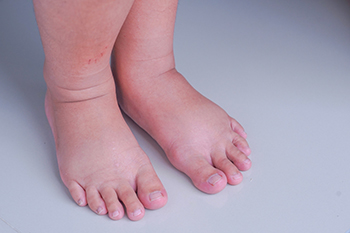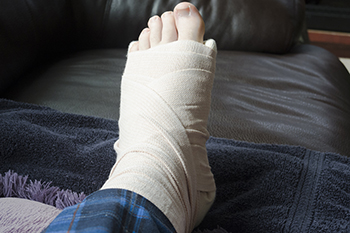Blog
Items filtered by date: July 2022
Unusual Causes of Swollen Ankles

Peripheral edema is the accumulation of fluids that cause swelling in the lower limbs, such as the ankles. Edema is typically not painful unless it is related to an injury. Swollen ankles are more common in the aged. Health conditions that cause such swelling include pregnancy, heart disease, obesity, and arthritis. Certain medications can also cause or aggravate peripheral edema. Otherwise, swollen ankles usually come from wearing ill-fitting shoes, or sitting, standing, or walking too long. More unusual causes of swollen ankles are wearing tight pants or clothes with elastic ankle seams that can restrict blood flow to the ankles and feet, excessive intake of sodium causing the body to retain water, insect bites, bacterial infections, interference of proper blood flow (from things like blood clots or varicose veins). Other possible causes are lymphedema or malfunction of lymph nodes that prevents flushing of viruses, bacteria, and toxins in the body, kidney, heart, or liver disease, and prolonged inactivity. If swollen ankles are a problem for you, cause you pain, or if the onset of swollen ankles is sudden, it is suggest you see a podiatrist immediately.
Ankle pain can have many different causes and the pain may potentially be serious. If you have ankle pain, consult with one of our doctors from Kitsap Foot & Ankle Clinic. Our doctors will assess your condition and provide you with quality foot and ankle treatment.
Ankle pain is any condition that causes pain in the ankle. Due to the fact that the ankle consists of tendons, muscles, bones, and ligaments, ankle pain can come from a number of different conditions.
Causes
The most common causes of ankle pain include:
- Types of arthritis (rheumatoid, osteoarthritis, and gout)
- Ankle sprains
- Broken ankles
- Achilles tendinitis
- Achilles tendon rupture
- Stress fractures
- Tarsal tunnel syndrome
- Plantar fasciitis
Symptoms
Symptoms of ankle injury vary based upon the condition. Pain may include general pain and discomfort, swelling, aching, redness, bruising, burning or stabbing sensations, and/or loss of sensation.
Diagnosis
Due to the wide variety of potential causes of ankle pain, podiatrists will utilize a number of different methods to properly diagnose ankle pain. This can include asking for personal and family medical histories and of any recent injuries. Further diagnosis may include sensation tests, a physical examination, and potentially x-rays or other imaging tests.
Treatment
Just as the range of causes varies widely, so do treatments. Some more common treatments are rest, ice packs, keeping pressure off the foot, orthotics and braces, medication for inflammation and pain, and surgery.
If you have any questions, please feel free to contact one of our offices located in Bremerton and Port Orchard, WA . We offer the newest diagnostic and treatment technologies for all your foot care needs.
Why Live with Pain and Numbness in Your Feet?
Tips for Managing Arthritis in the Feet

If you suffer from arthritis, you should know that you might be at an especially high risk of experiencing complications in your feet. For example, you may experience swelling and redness in the joints of your feet or you may even have severe pain when moving your feet. There are several things you can do by yourself at home to help manage the effects of arthritis and your feet. First, to treat swelling, you might consider applying an ice pack to the affected area of the feet. You might apply the ice for ten minutes, always being sure to use a towel to separate the pack from making direct contact with the skin. If your arthritis is making you experience plantar fasciitis in your feet, you might also consider rolling your feet over a water bottle. To do this, get a cold water bottle and roll the bottom of each foot back and forth over the bottle while sitting down. If you have arthritis, it is important to contact a podiatrist who can help you manage your condition.
Arthritis can be a difficult condition to live with. If you are seeking treatment, contact one of our doctors from Kitsap Foot & Ankle Clinic. Our doctors can provide the care you need to keep you pain-free and on your feet.
Arthritic Foot Care
Arthritis is a joint disorder that involves the inflammation of different joints in your body, such as those in your feet. Arthritis is often caused by a degenerative joint disease and causes mild to severe pain in all affected areas. In addition to this, swelling and stiffness in the affected joints can also be a common symptom of arthritis.
In many cases, wearing ill-fitting shoes can worsen the effects and pain of arthritis. Wearing shoes that have a lower heel and extra room can help your feet feel more comfortable. In cases of rheumatoid arthritis, the arch in your foot may become problematic. Buying shoes with proper arch support that contour to your feet can help immensely.
Alleviating Arthritic Pain
- Exercises that stretch the foot can prevent further pain and injury and increase mobility
- Most of the pain can be alleviated with anti-inflammatory drugs, heat, and topical medications
- Massages can help temporarily alleviate pain.
It is best to see your doctor for the treatment that is right for your needs and symptoms. Conditions vary, and a podiatrist can help you determine the right method of care for your feet.
If you have any questions, please feel free to contact one of our offices located in Bremerton and Port Orchard, WA . We offer the newest diagnostic tools and technology to treat your foot and ankle needs.
What Is a Plantar Fibroma?

A plantar fibroma is a benign, noncancerous, growth that is less than one inch in size and develops in the arch of the foot. It grows in the plantar fascia, the thick, fibrous tissue that runs across the bottom of the foot and stabilizes the foot arch. A plantar fibroma can develop on one or both feet. Anyone can develop a plantar fibroma, but it is most apt to occur in young or middle-aged adults and males. This growth appears on the bottom of the foot in the middle of the arch. It is characterized by small bumps that can be painless at first but become painful as the nodules grow larger. Since there is no known cause of a plantar fibroma, there is no way to prevent it. If you suspect you have a plantar fibroma, consult with a podiatrist who can make a diagnosis and provide treatment for it, or any other foot or ankle condition found.
A plantar fibroma may disrupt your daily activities. If you have any concerns, contact one of our doctors of Kitsap Foot & Ankle Clinic. Our doctors can provide the care you need to keep you pain-free and on your feet.
Plantar Fibroma
A plantar fibroma is a fibrous knot in the arch of the foot. It is embedded in the plantar fascia which is a band of tissue that extends from the heel to the toes along the bottom of the foot. There can be multiple plantar fibromas in the feet at the same time. There are no known causes for this condition. If you have a plantar fibroma, there will be a bump in the arch of your foot that cannot be missed. Any associated pain is most often due to a shoe rubbing against the nodule. Non-surgical options, such as steroid injections, physical therapy, and orthotics should be tried first. Surgery is a last resort and is the only thing that will remove a plantar fibroma entirely. Consult with a podiatrist for a proper diagnosis and to determine the treatment regimen that is right for you.
What Causes a Plantar Fibroma?
While there are no specific causes identified, a plantar fibroma can possibly come from genetic predisposition or the formation of scar tissue that forms from healing the tears in the plantar fascia.
What Are the Symptoms of a Plantar Fibroma?
There will be a noticeable lump in the arch of the foot that may or may not cause pain. If pain is felt, it is typically because a shoe is rubbing up against the lump or when walking or standing barefoot.
Treatment and Prevention
A plantar fibroma will not disappear without treatment, but it can get smaller and be a non-issue. If pain persists, a podiatrist examines the foot and when the arch of the foot is pressed, pain can be felt down to the toes. An MRI or biopsy might be performed to help diagnose or evaluate the plantar fibroma. The following non-surgical options are generally enough to reduce the size and pain of these nodules:
- Steroid injections
- Orthotics
- Physical therapy to help apply anti-inflammatory creams on the bump
Surgery is considered if the mass increases in size and the patient continues to feel pain after non-surgical methods are tried.
If you have any questions please feel free to contact one of our offices located in Bremerton and Port Orchard, WA . We offer the newest diagnostic tools and technology to treat your foot and ankle needs.
Foot Stress Fractures

A stress fracture in the foot is a small crack or break in a bone. This type of fracture is also known as a hairline fracture. Stress fractures most often happen in weight-bearing bones among people who participate in repetitive activities that put a lot of stress on the feet. They are also due to a sudden change in activities or surfaces, or an abnormal foot structure. Those most at risk for stress fractures are women, those with low levels of vitamin D and calcium, those with osteoporosis, those taking certain medications, and those who have previously sustained foot stress fractures. Stress fractures can occur in any bone of the foot but most often happen to the second and third metatarsal bones – the long bones that connect the toes to the ankle. These are the bones that bear the most stress when pushing off the foot. A stress fracture must heal properly to prevent worse injuries from occurring. Stress fractures of the foot cause pain, which gets worse when walking or bearing weight. The pain may ease when resting and return when activity commences. Stress fractures can be prevented by warming up before participating in activities that put stress on the feet, cross-training rather than focusing on a single sport, wearing properly fitted shoes for the activity, eating a healthy diet (with enough vitamin D and calcium), and checking in with doctors about possible side effects of medicines they are taking. If you feel you have a foot stress fracture, you might see a podiatrist for proper diagnosis and treatment as soon as possible.
Activities where too much pressure is put on the feet can cause stress fractures. To learn more, contact one of our doctors from Kitsap Foot & Ankle Clinic. Our doctors can provide the care you need to keep your pain free and on your feet.
Dealing with Stress Fractures of the Foot and Ankle
Stress fractures occur in the foot and ankle when muscles in these areas weaken from too much or too little use. The feet and ankles then lose support when walking or running from the impact of the ground. Since there is no protection, the bones receive the full impact of each step. Stress on the feet can cause cracks to form in the bones, thus creating stress fractures.
What Are Stress Fractures?
Stress fractures occur frequently in individuals whose daily activities cause great impact on the feet and ankles. Stress factors are most common among:
- Runners
- People affected with Osteoporosis
- Tennis or basketball players
- Gymnasts
- High impact workouts
Symptoms
Pain from the fractures occur in the area of the fractures and can be constant or intermittent. It will often cause sharp or dull pain with swelling and tenderness. Engaging in any kind of activity which involves high impact will aggravate pain.
If you have any questions please feel free to contact one of our offices located in Bremerton and Port Orchard, WA . We offer the newest diagnostic and treatment technologies for all your foot and ankle needs.

